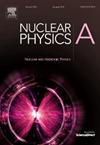FRIB天体物理学同分异构体研究的机会
IF 2.5
4区 物理与天体物理
Q2 PHYSICS, NUCLEAR
引用次数: 0
摘要
核同分异构体在天体物理核合成中的作用正受到越来越多的关注,因为地面反应和同分异构体状态对决定反应速率和反应网络内的流动都具有潜在的重要意义。一个特殊的例子是sd壳层中的奇数-奇数N=Z核素,它们在新星核合成中从CNO循环中突围起重要作用,影响反应流、核合成终点和最终丰度,影响潜在的天文观测值。因为这些核素中的许多都有较低的异构体,所以在基态和异构体状态下限制反应是很重要的。放射性束流设施的发展正在通过直接和间接技术开辟这种机会。利用一种新技术在不影响离子光学的情况下操纵再加速光束中的地面/异构体含量,首次测量已被用于研究38K,这将适用于在新生的稀有同位素光束设施中对34Cl和其他物质的测量。本文章由计算机程序翻译,如有差异,请以英文原文为准。
Opportunities for isomer studies for astrophysics at FRIB
The role of nuclear isomers in astrophysical nucleosynthesis is gaining increased attention, as reactions on ground and isomeric states are both potentially important for determining the reaction rates and flow within the reaction network. A particular case is the odd-odd N=Z nuclides in the sd-shell, which play an important role in breakout from the CNO cycle in nova nucleosynthesis, affecting reaction flow, the nucleosynthesis end-point, and final abundances, impacting potential astronomical observables. Because many of these nuclides have low-lying isomers, it is important to constrain reactions on both ground and isomeric states. Developments in radioactive-beam facilities are opening such opportunities, via direct and indirect techniques. The first measurement using a new technique for manipulating ground/isomer content in reaccelerated beams without affecting ion optics, has been employed to study 38K, which will be applicable to measurements on 34Cl and others at the nascent Facility for Rare Isotope Beams.
求助全文
通过发布文献求助,成功后即可免费获取论文全文。
去求助
来源期刊

Nuclear Physics A
物理-物理:核物理
CiteScore
3.60
自引率
7.10%
发文量
113
审稿时长
61 days
期刊介绍:
Nuclear Physics A focuses on the domain of nuclear and hadronic physics and includes the following subsections: Nuclear Structure and Dynamics; Intermediate and High Energy Heavy Ion Physics; Hadronic Physics; Electromagnetic and Weak Interactions; Nuclear Astrophysics. The emphasis is on original research papers. A number of carefully selected and reviewed conference proceedings are published as an integral part of the journal.
 求助内容:
求助内容: 应助结果提醒方式:
应助结果提醒方式:


